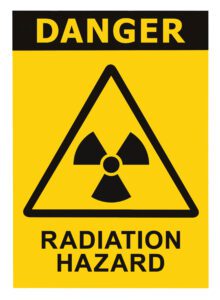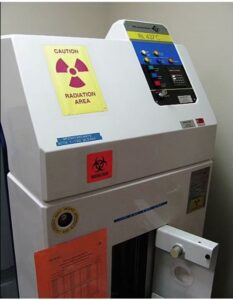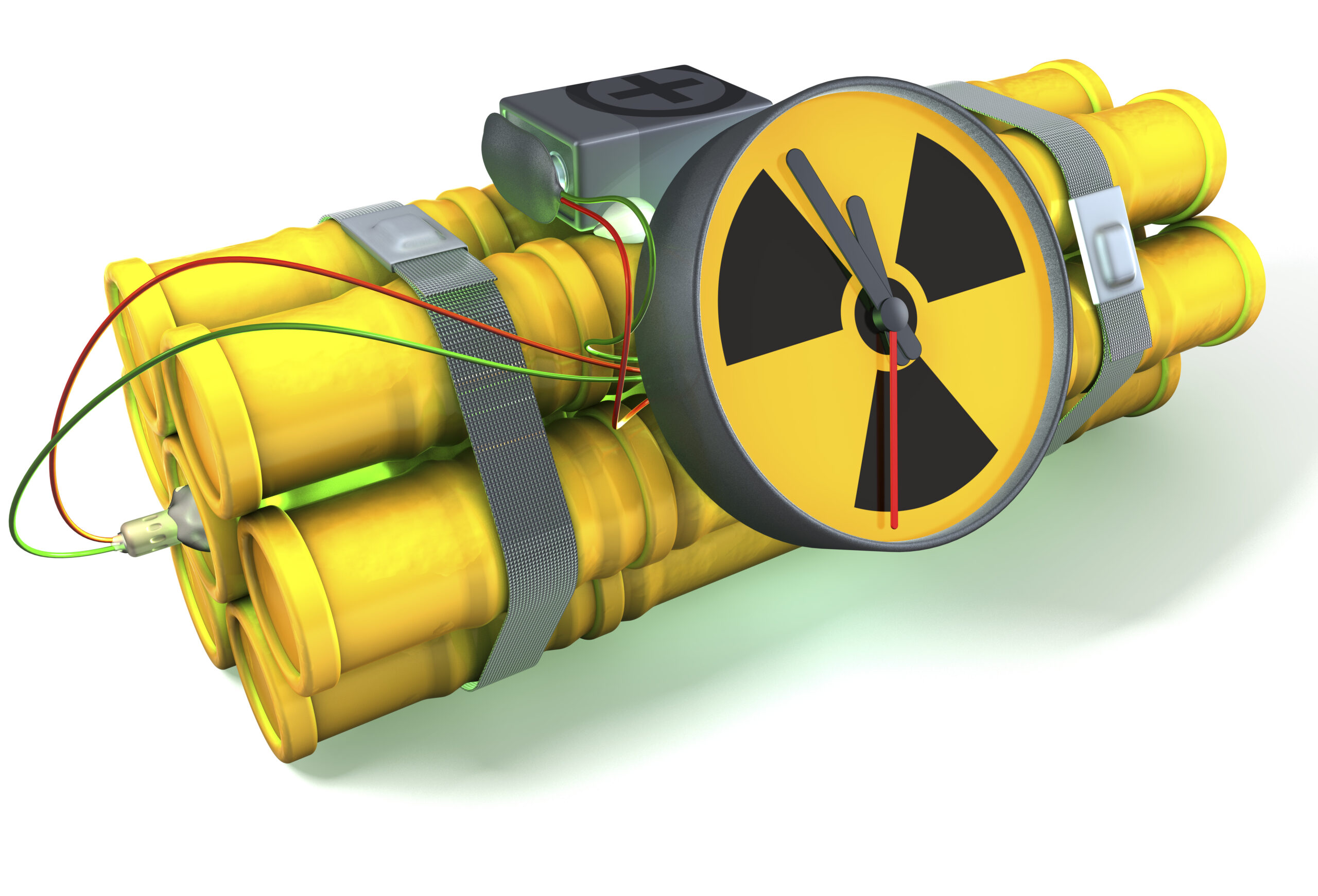We are updating this post, originally published in 2009, to underscore the need to replace Cesium irradiation devices to prevent easy access to material to make a Dirty Bomb, described by the Nuclear Regulatory Commission as:
 “A “dirty bomb” is one type of a “radiological dispersal device” (RDD) that combines a conventional explosive, such as dynamite, with radioactive material. The terms dirty bomb and RDD are often used interchangeably in the media. Most RDDs would not release enough radiation to kill people or cause severe illness – the conventional explosive would be more harmful to individuals than the radioactive material. However, depending on the scenario, an RDD explosion could create fear and panic, contaminate property, and require potentially costly cleanup. Making prompt, accurate information available to the public could prevent the panic sought by terrorists.”
“A “dirty bomb” is one type of a “radiological dispersal device” (RDD) that combines a conventional explosive, such as dynamite, with radioactive material. The terms dirty bomb and RDD are often used interchangeably in the media. Most RDDs would not release enough radiation to kill people or cause severe illness – the conventional explosive would be more harmful to individuals than the radioactive material. However, depending on the scenario, an RDD explosion could create fear and panic, contaminate property, and require potentially costly cleanup. Making prompt, accurate information available to the public could prevent the panic sought by terrorists.”
Since 2009, there has been some progress in replacing the Cesium 137 machines with less dangerous and equally effective Xray equivalents, however, much remains to be done, particularly in the Boston area of Massachusetts, where some of the best healthcare facilities in the US, if not the world, operate. Other states with a high concentration of cancer and research facilities are also ripe targets for terrorists.
Below is an illustration of how quickly Cesium could fall into the wrong hands.
 The question:
What does the following report from local news media have to do, if anything, with the explosion of a so-called dirty bomb?
On September 9, 2009, at 8:30 p.m., two men, armed only with a clipboard and dolly, made their way to the ATM machine in the cafe area of Delaware County Memorial Hospital in Upper Darby, PA, and in less than two minutes, cut the machine’s wires, loaded it onto the dolly, and wheeled it to the parking garage elevators.  In the garage, they loaded the machine into a white van and, after paying for parking, drove off $100,000 richer. The van was found the next day by Philadelphia Police. It was torched with an empty ATM inside. The men have not been captured. The ATM was not bolted to the wall but did have an alarm. Upper Darby Police Superintendent Michael Chitwood said the suspects could bypass it by tripping the machine’s power failure safety feature first.
The answer:
Everything.
From the Oklahoma City bombings in 1995, and especially since September 11, 2001, concern about our vulnerability to the dirty bomb has been voiced in numerous articles and reports, as well as other Congressional testimony. For example, in an article in the November 2002 issue of Scientific American magazine, physicists Michael A. Levi and Henry C. Kelly identified dirty bombs as “not weapons of mass destruction but weapons of mass disruption, these devices could wreak economic havoc by making target areas off-limits for an extended period.†Using a computer model developed by the Lawrence Livermore National Laboratory, they projected that, depending on wind conditions and other factors, radiation from the explosion of a dirty bomb in New York City would make an area of about 100 blocks unlivable for 30 years. A much larger area would be off-limits while it was decontaminated.
 For example, a dirty bomb exploding at the Port Authority at 42nd Street and Eighth Avenue, would kill few people immediately, but “destroy†for 20 to 40 years landmarks and infrastructure such as Penn Station, the Theater District, Lincoln Center, hundreds of office buildings, stores, and apartment buildings. The region would resemble a huge ghost town, probably surrounded by wired fencing and patrolled by police in radiation-protected cars. The clean-up cost would be hundreds of billions of dollars, and lost opportunity costs could run into trillions.
For example, a dirty bomb exploding at the Port Authority at 42nd Street and Eighth Avenue, would kill few people immediately, but “destroy†for 20 to 40 years landmarks and infrastructure such as Penn Station, the Theater District, Lincoln Center, hundreds of office buildings, stores, and apartment buildings. The region would resemble a huge ghost town, probably surrounded by wired fencing and patrolled by police in radiation-protected cars. The clean-up cost would be hundreds of billions of dollars, and lost opportunity costs could run into trillions.
In its 2007 Summer Study, the Defense Science Board, a federal advisory committee established to provide independent advice to the Secretary of Defense, characterized the over 1,000 cesium-137 in blood irradiators, research irradiators, and calibration irradiators, mostly in hospitals, as “low hanging fruit†for terrorists. “Violation of any one of these sources could shut down 25 square kilometers anywhere in the United States for 40 or more years,†the study said. It recommended an investment of $200 million over a five-year period to buy up the Cs-137 machines and replace them with e-beam irradiators or cobalt sources that would eliminate the most dangerous domestic RDD threat. “The study urges the Assistant Secretary for Homeland Defense to lead DOD advocacy to replace these devices.â€
Back in 2012, this recommendation had gone unheeded here in the US. Differing action was taken to secure these devices in the UK, where MI5 revealed that terrorists were seeking materials for the dreaded “dirty bombâ€, while they simultaneously identified Islamist extremist physicians planning and willing to be suicide bombers. in the U.K., it was deemed a clear and present danger and resulted in urgent, nationwide action to remove the devices using the National Health Service authority on a mandatory basis, unlike in the US, where compliance is encouraged but not mandatory. France, Japan, and Norway followed suit and replaced all their irradiators.
 In the US, the National Nuclear Security Administration (NNSA) has been given funding to harden buildings and retrofit radiological equipment in hospitals and research facilities. The cost is $320,000 per facility, with $10,000 a year required for upkeep, according to the 12-925GAO report. But the program is voluntary. That is what Mr. Aloise meant when he termed the rules for securing such equipment “flexible.†Currently, some 300 irradiators have been retrofitted since 2007, with the rest projected to be completed by 2025 – which, as of 10/2023, seems highly unlikely. On the other hand, in the US, at least 25% of physicians are International Medical Graduates (IMGs), a large percentage of whom have unrestricted access to equipment with dangerous amounts of cesium-137 and cobalt-60, in many cases without proper background checks. Here in the US, a higher level of vigilance is required.
In the US, the National Nuclear Security Administration (NNSA) has been given funding to harden buildings and retrofit radiological equipment in hospitals and research facilities. The cost is $320,000 per facility, with $10,000 a year required for upkeep, according to the 12-925GAO report. But the program is voluntary. That is what Mr. Aloise meant when he termed the rules for securing such equipment “flexible.†Currently, some 300 irradiators have been retrofitted since 2007, with the rest projected to be completed by 2025 – which, as of 10/2023, seems highly unlikely. On the other hand, in the US, at least 25% of physicians are International Medical Graduates (IMGs), a large percentage of whom have unrestricted access to equipment with dangerous amounts of cesium-137 and cobalt-60, in many cases without proper background checks. Here in the US, a higher level of vigilance is required.
An article in the Boston Globe in July 2023 rekindled our interest in this topic as some states have decided to mitigate this risk, and others have decided not to act.
For those interested in preventing a dirty bomb and replacing the dangerous equipment with equally effective and less dangerous new technology, the NTI has worked with many organizations on large-scale replacement projects. Quoting from their Preventing a Dirty Bomb Case Studies  paper:
“Cesium-137 blood irradiators once were regarded as the most effective technology for sterilizing blood. In recent years, however, there have been significant technological advances in developing effective and safe alternative technologies that do not use radiological isotopes and have equivalent medical outcomes. In the United States, for example, the U.S. Food and Drug Administration (FDA) 2012 approved using nonradioactive x-ray devices. As of 2015, two types of these devices were available, with a typical cost between $200,000 and $270,000 per unit. In addition to being a relatively inexpensive replacement for cesium-137 blood irradiators, the x-ray units require far less security and shielding, eliminate liability, and entail no expensive disposal at the end of their life cycle. Those factors make replacement much more cost-effective than increasing security around radiological sources—and replacement eliminates the risk. Replacement also protects hospitals that don’t have insurance to cover terrorism losses; otherwise, there is a possibility of financial devastation from having to pay huge damages in the wake of a dirty bomb attack using hospital materials.â€
While the risk of Islamic Extremist terror threats may seem to have moved to the background, our wide-open border is allowing tens of thousands of unchecked migrants into the country, 2.4 million migrants entering from 120+ countries in 2023, and many hostile to us – carrying fentanyl and other narcotics, trafficking arms and human beings, bringing disease, and maybe even Cesium, Cobalt, etc. which is subject to loss of control in less developed countries.
It is in the public interest to take the necessary steps to secure its “low-hanging fruit†as soon as possible. However, based on experience with Republican and Democratic administrations and Congressmen of all stripes, this will not be done until a disaster strikes. Therefore, it behooves interested citizens and the media to act. In each city, the names of hospitals that have not taken the necessary action to prevent theft and misuse of irradiation equipment should be publicized. Those who have voluntarily made the replacements can promote their commitment to patients, employees, and community safety and security, pressuring the laggards to act.
Given the current Regulatory Capture and apathy of the medical community, legislation to better protect us is required. In the case of this article, we underlined the facts as presented by the Boston Globe piece, and called several institutions to ask if the information is accurate and if they had any plans to address the issues, including Brigham and Women’s Hospital, Mass General, Dana Farber Cancer Institute, Boston Children’s Hospital, and Tuft’s Medical Center. We received no substantial replies.






0 Comments